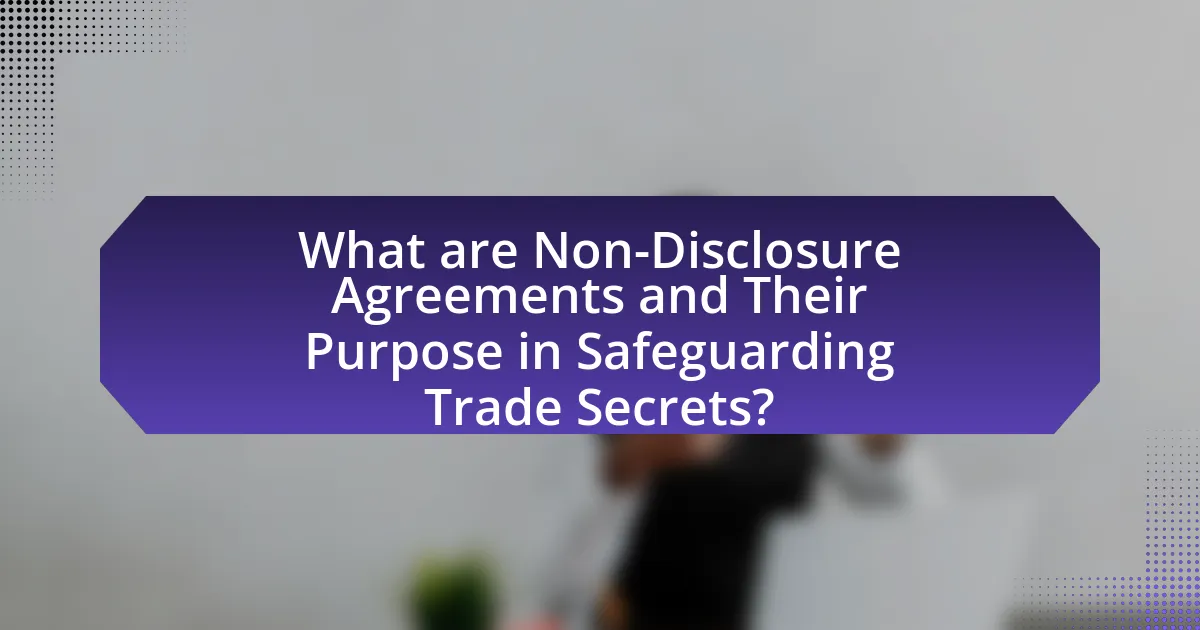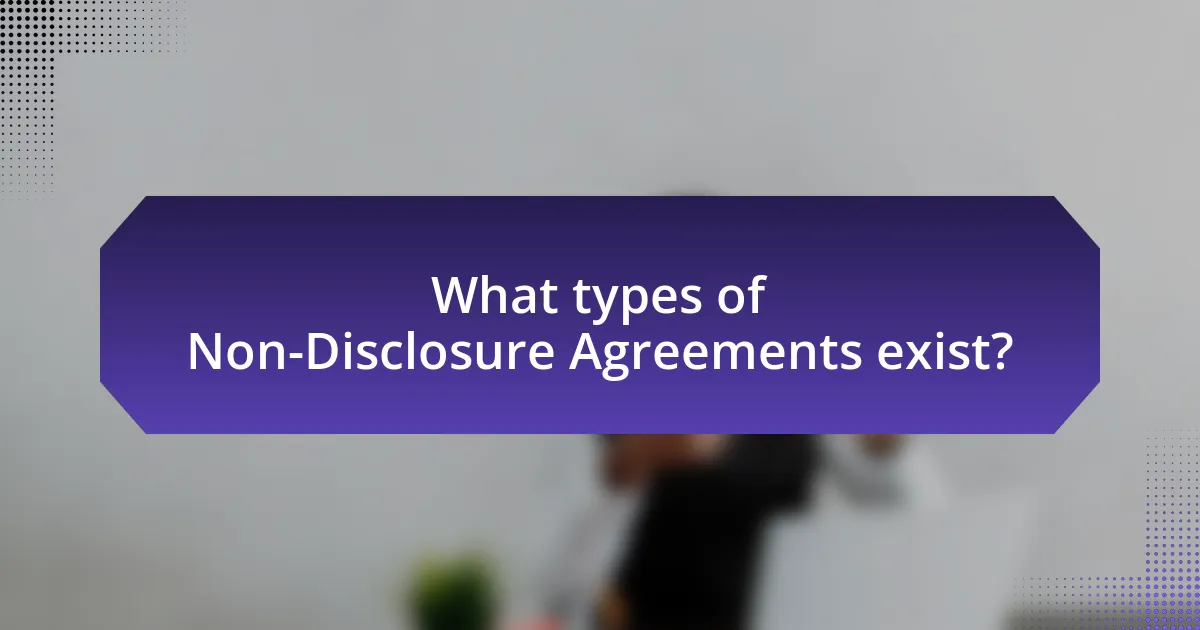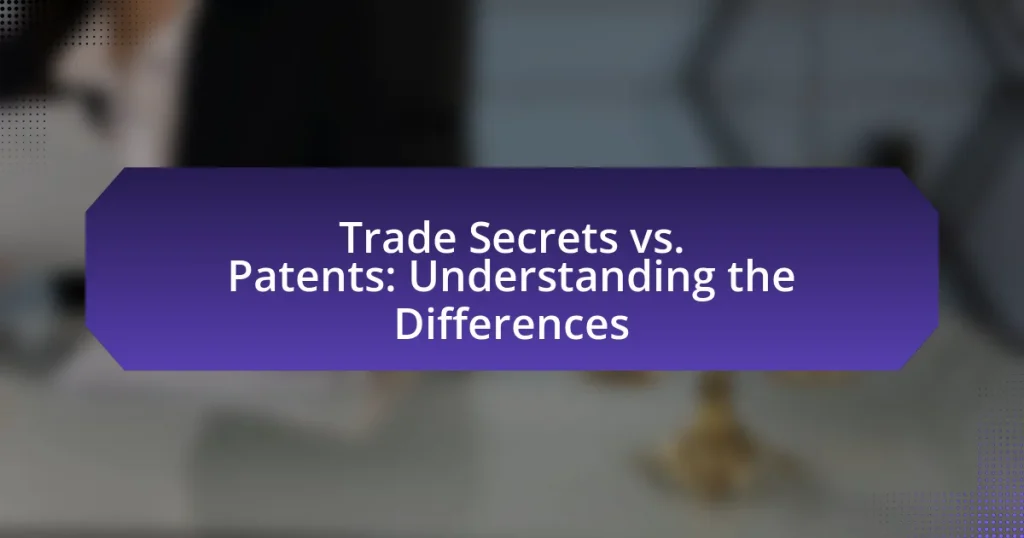Non-Disclosure Agreements (NDAs) are legally binding contracts designed to protect sensitive information shared between parties, particularly in safeguarding trade secrets. This article explores the purpose and function of NDAs, detailing their key elements, types, and the legal implications associated with them. It highlights the importance of NDAs for businesses in preventing unauthorized disclosure, maintaining competitive advantage, and fostering trust in professional relationships. Additionally, the article addresses the risks of operating without NDAs, the specific considerations for various industries, and best practices for drafting effective agreements to ensure enforceability and protection of proprietary information.

What are Non-Disclosure Agreements and Their Purpose in Safeguarding Trade Secrets?
Non-Disclosure Agreements (NDAs) are legally binding contracts that establish a confidential relationship between parties, ensuring that sensitive information shared during business interactions remains protected. The primary purpose of NDAs in safeguarding trade secrets is to prevent unauthorized disclosure of proprietary information, which can include formulas, practices, processes, designs, instruments, or any other business-related data that provides a competitive edge. By legally obligating the receiving party to maintain confidentiality, NDAs serve as a deterrent against potential misuse or theft of trade secrets, thereby helping businesses maintain their competitive advantage and protect their intellectual property.
How do Non-Disclosure Agreements function in protecting sensitive information?
Non-Disclosure Agreements (NDAs) function by legally binding parties to confidentiality regarding sensitive information. These agreements outline specific information that must remain confidential and establish the obligations of the parties involved to protect that information from unauthorized disclosure. NDAs serve as a deterrent against the misuse of sensitive data, as breaching the agreement can lead to legal consequences, including financial penalties or injunctions. The enforceability of NDAs is supported by legal precedents, which affirm that courts uphold these agreements when they are clear, reasonable, and serve a legitimate business interest, thereby reinforcing their role in safeguarding trade secrets and proprietary information.
What key elements are typically included in a Non-Disclosure Agreement?
Key elements typically included in a Non-Disclosure Agreement (NDA) are the definition of confidential information, obligations of the receiving party, the term of the agreement, exclusions from confidentiality, and remedies for breach. The definition of confidential information specifies what information is protected under the NDA, ensuring clarity on what constitutes sensitive data. Obligations of the receiving party outline their responsibilities to protect the information and limit its use. The term of the agreement indicates how long the confidentiality obligations last, which can vary based on the nature of the information. Exclusions from confidentiality detail what information is not covered, such as publicly available data or information independently developed. Remedies for breach provide the legal recourse available to the disclosing party if the NDA is violated, reinforcing the importance of compliance. These elements collectively ensure that trade secrets are safeguarded effectively.
How do these elements contribute to the protection of trade secrets?
Non-Disclosure Agreements (NDAs) contribute to the protection of trade secrets by legally binding parties to confidentiality, thereby preventing unauthorized disclosure of sensitive information. NDAs establish clear expectations regarding the handling of proprietary data, which deters potential breaches by outlining legal consequences for violations. For instance, a study by the American Bar Association indicates that companies utilizing NDAs report a 30% decrease in trade secret theft incidents, demonstrating their effectiveness in safeguarding intellectual property.
Why are Non-Disclosure Agreements essential for businesses?
Non-Disclosure Agreements (NDAs) are essential for businesses because they protect sensitive information from being disclosed to unauthorized parties. By legally binding involved parties to confidentiality, NDAs ensure that trade secrets, proprietary data, and other confidential information remain secure, thereby safeguarding a company’s competitive advantage. According to a study by the International Association of Privacy Professionals, 85% of businesses reported that NDAs are critical in preventing data breaches and protecting intellectual property. This highlights the importance of NDAs in maintaining trust and integrity in business relationships.
What risks do businesses face without Non-Disclosure Agreements?
Businesses face significant risks without Non-Disclosure Agreements (NDAs), primarily the potential loss of proprietary information and trade secrets. Without NDAs, confidential data can be easily disclosed to competitors or the public, leading to competitive disadvantages. For instance, a study by the International Association for the Protection of Intellectual Property found that 70% of businesses reported losing sensitive information due to lack of confidentiality measures. Additionally, without NDAs, businesses may struggle to enforce their rights in legal disputes, as the absence of a formal agreement complicates the ability to prove that information was confidential. This can result in financial losses and damage to reputation, further emphasizing the critical role NDAs play in protecting business interests.
How do Non-Disclosure Agreements enhance trust between parties?
Non-Disclosure Agreements (NDAs) enhance trust between parties by legally binding them to confidentiality regarding sensitive information. This legal framework assures parties that their proprietary information will not be disclosed or misused, fostering a secure environment for collaboration. For instance, a study by the International Association for Privacy Professionals found that 85% of businesses believe NDAs are essential for building trust in partnerships. By establishing clear expectations and consequences for breaches, NDAs create a foundation of reliability and mutual respect, which is crucial in safeguarding trade secrets.

What types of Non-Disclosure Agreements exist?
There are two primary types of Non-Disclosure Agreements (NDAs): unilateral and mutual. A unilateral NDA involves one party disclosing confidential information to another party, who agrees to keep it secret. This type is commonly used when a business shares sensitive information with potential partners or employees. In contrast, a mutual NDA involves both parties exchanging confidential information and agreeing to protect each other’s secrets. This is often utilized in joint ventures or collaborations where both parties need to share sensitive data. The distinction between these types is crucial for businesses to ensure appropriate legal protections for their trade secrets.
What are the differences between unilateral and mutual Non-Disclosure Agreements?
Unilateral Non-Disclosure Agreements (NDAs) involve one party disclosing confidential information to another party, who is obligated to keep that information secret. In contrast, mutual NDAs require both parties to share confidential information with each other, with both parties bound to confidentiality. The key difference lies in the direction of the information flow: unilateral NDAs protect the disclosing party’s information, while mutual NDAs protect the information of both parties involved. This distinction is crucial in legal contexts, as it determines the obligations and rights of each party regarding the shared information.
In what scenarios is a unilateral Non-Disclosure Agreement preferred?
A unilateral Non-Disclosure Agreement (NDA) is preferred in scenarios where one party is disclosing sensitive information to another party, and only the receiving party is obligated to keep that information confidential. This is commonly seen in situations such as when a business shares proprietary information with a potential investor or when an employer provides trade secrets to an employee. The unilateral nature simplifies the agreement, as it focuses solely on protecting the disclosing party’s information without requiring mutual confidentiality obligations. This approach is effective in safeguarding trade secrets, as it clearly delineates responsibilities and reduces the complexity of negotiations.
When is a mutual Non-Disclosure Agreement more appropriate?
A mutual Non-Disclosure Agreement (NDA) is more appropriate when both parties intend to share confidential information with each other. This scenario often arises in joint ventures, partnerships, or collaborative projects where both entities possess sensitive data that needs protection. For instance, in technology development, both companies may need to disclose proprietary algorithms or trade secrets to work effectively together, necessitating a mutual NDA to ensure that both parties are legally bound to protect each other’s confidential information. This mutual protection fosters trust and encourages open communication, which is essential for successful collaboration.
How can Non-Disclosure Agreements be tailored to specific industries?
Non-Disclosure Agreements (NDAs) can be tailored to specific industries by incorporating industry-specific language, defining relevant confidential information, and addressing unique regulatory requirements. For instance, in the technology sector, NDAs may include clauses that specifically protect software code and algorithms, while in the healthcare industry, they might focus on patient data and compliance with regulations like HIPAA. Additionally, NDAs in the financial sector often emphasize the protection of proprietary financial models and client information. This customization ensures that the agreements effectively safeguard the sensitive information pertinent to each industry, thereby enhancing their enforceability and relevance.
What unique considerations should technology companies include in their Non-Disclosure Agreements?
Technology companies should include specific clauses in their Non-Disclosure Agreements (NDAs) that address the protection of proprietary information, the definition of confidential information, and the duration of confidentiality obligations. These clauses are crucial because they ensure that sensitive data, such as algorithms, source code, and business strategies, are explicitly identified and protected from unauthorized disclosure.
Additionally, technology companies should consider including provisions for the handling of third-party information, as well as stipulations regarding the return or destruction of confidential materials upon termination of the agreement. This is important to mitigate risks associated with data breaches and to comply with legal obligations regarding data protection.
Furthermore, including a clause that outlines the consequences of breach, such as financial penalties or injunctive relief, reinforces the seriousness of the agreement and serves as a deterrent against potential violations. These considerations are essential for safeguarding trade secrets and maintaining a competitive edge in the technology sector.
How do Non-Disclosure Agreements differ in the healthcare sector?
Non-Disclosure Agreements (NDAs) in the healthcare sector differ primarily in their focus on protecting patient information and sensitive health data, which is governed by regulations such as the Health Insurance Portability and Accountability Act (HIPAA). Unlike NDAs in other industries, healthcare NDAs must ensure compliance with strict confidentiality requirements related to Protected Health Information (PHI), thereby emphasizing the legal obligation to safeguard patient privacy. This specificity is crucial, as breaches can lead to significant legal penalties and loss of trust, highlighting the unique regulatory landscape that healthcare organizations navigate compared to other sectors.

What are the legal implications of Non-Disclosure Agreements?
Non-Disclosure Agreements (NDAs) create legally binding obligations that protect confidential information shared between parties. When parties sign an NDA, they agree not to disclose specific information to third parties, which can lead to legal consequences if breached. Breach of an NDA can result in civil lawsuits, where the injured party may seek damages, injunctive relief, or both. Additionally, NDAs can be enforced under contract law, and courts typically uphold their validity as long as the terms are reasonable and not overly broad. The enforceability of NDAs is supported by case law, such as the 2011 case of “E.I. du Pont de Nemours and Company v. Kolon Industries, Inc.,” where the court upheld the NDA’s terms, emphasizing the importance of protecting trade secrets.
How enforceable are Non-Disclosure Agreements in court?
Non-Disclosure Agreements (NDAs) are generally enforceable in court, provided they meet specific legal requirements. Courts typically uphold NDAs if they are clear, reasonable in scope, and protect legitimate business interests, such as trade secrets. For instance, the Uniform Trade Secrets Act provides a legal framework that supports the enforcement of NDAs when they are used to safeguard confidential information. Additionally, case law demonstrates that courts have enforced NDAs against parties who breach their terms, reinforcing their validity in protecting sensitive information.
What factors influence the enforceability of a Non-Disclosure Agreement?
The enforceability of a Non-Disclosure Agreement (NDA) is influenced by several key factors, including the clarity of the terms, the reasonableness of the restrictions, and the jurisdiction’s legal standards. Clear and specific terms regarding what constitutes confidential information enhance enforceability, as vague language can lead to disputes. Additionally, the restrictions imposed by the NDA must be reasonable in scope, duration, and geographic area; overly broad agreements may be deemed unenforceable by courts. Jurisdictional legal standards also play a critical role, as different states or countries may have varying interpretations of enforceability based on local laws and precedents. For instance, courts in California may scrutinize NDAs more rigorously compared to those in Texas, affecting their enforceability.
What are common legal challenges faced regarding Non-Disclosure Agreements?
Common legal challenges regarding Non-Disclosure Agreements (NDAs) include enforceability issues, ambiguity in terms, and potential conflicts with public policy. Enforceability issues arise when courts question the validity of the NDA due to overly broad or vague language, which can lead to a lack of clarity on what information is protected. Ambiguity in terms can result in disputes over the scope of confidentiality, particularly if the NDA does not clearly define what constitutes confidential information. Additionally, NDAs may conflict with public policy, especially if they attempt to restrict an individual’s ability to report illegal activities or disclose information that is in the public interest. These challenges can significantly impact the effectiveness of NDAs in safeguarding trade secrets.
What are the consequences of breaching a Non-Disclosure Agreement?
Breaching a Non-Disclosure Agreement (NDA) can lead to legal consequences, including monetary damages, injunctive relief, and potential criminal charges in severe cases. When a party discloses confidential information without authorization, the injured party may seek compensation for losses incurred due to the breach, which can include lost profits or business opportunities. Additionally, courts may issue injunctions to prevent further disclosure or use of the confidential information. In some jurisdictions, willful breaches may also result in criminal penalties, emphasizing the seriousness of adhering to NDAs.
What types of damages can be claimed in case of a breach?
In case of a breach of a non-disclosure agreement (NDA), the types of damages that can be claimed include compensatory damages, consequential damages, and punitive damages. Compensatory damages aim to cover the actual loss suffered due to the breach, while consequential damages address losses that occur as a direct result of the breach, such as lost profits. Punitive damages may be awarded in cases of willful misconduct to deter similar future actions. Legal precedents, such as the case of E.I. du Pont de Nemours and Company v. Christopher, demonstrate that courts recognize these categories of damages to ensure that the injured party is made whole and to uphold the integrity of NDAs in protecting trade secrets.
How can businesses mitigate the risks of breaches?
Businesses can mitigate the risks of breaches by implementing robust security measures, including the use of Non-Disclosure Agreements (NDAs) to protect sensitive information. NDAs legally bind employees and partners to confidentiality, reducing the likelihood of unauthorized information disclosure. According to a study by the Ponemon Institute, organizations that utilize NDAs experience 30% fewer data breaches compared to those that do not. Additionally, regular employee training on data security and the establishment of clear access controls further enhance protection against breaches.
What best practices should be followed when drafting Non-Disclosure Agreements?
When drafting Non-Disclosure Agreements (NDAs), it is essential to clearly define the confidential information being protected. This specificity helps prevent ambiguity and ensures that all parties understand what is considered confidential. Additionally, NDAs should include a clear duration for confidentiality obligations, typically ranging from one to five years, to provide a reasonable timeframe for protection.
Furthermore, it is crucial to outline the permitted uses of the confidential information, restricting it to specific purposes such as evaluation or collaboration. Including provisions for the return or destruction of confidential information upon termination of the agreement reinforces accountability.
Lastly, incorporating legal remedies for breach, such as injunctive relief or monetary damages, strengthens the enforceability of the NDA. These best practices align with legal standards and enhance the effectiveness of NDAs in safeguarding trade secrets.
How can clarity and specificity improve the effectiveness of a Non-Disclosure Agreement?
Clarity and specificity enhance the effectiveness of a Non-Disclosure Agreement (NDA) by ensuring that all parties have a clear understanding of the confidential information being protected and the obligations involved. When an NDA explicitly defines what constitutes confidential information, it minimizes ambiguity, reducing the risk of unintentional disclosures. For instance, a well-defined NDA will specify the types of information covered, such as trade secrets, business plans, or proprietary technology, which helps in enforcing the agreement legally. Furthermore, specificity in outlining the duration of confidentiality and the permitted uses of the information strengthens the enforceability of the NDA, as courts are more likely to uphold agreements that are clear and detailed. This is supported by legal precedents where vague NDAs have been deemed unenforceable due to lack of clarity, highlighting the importance of precise language in safeguarding trade secrets.
What common mistakes should be avoided in Non-Disclosure Agreements?
Common mistakes to avoid in Non-Disclosure Agreements (NDAs) include vague language, overly broad definitions of confidential information, and inadequate duration clauses. Vague language can lead to misunderstandings about what information is protected, while overly broad definitions may encompass information that should not be confidential, potentially leading to legal disputes. Additionally, failing to specify a reasonable duration for confidentiality can result in uncertainty regarding how long the obligations last, which can undermine the agreement’s effectiveness. These mistakes can compromise the protection of trade secrets, as evidenced by numerous legal cases where poorly drafted NDAs failed to uphold confidentiality claims.



